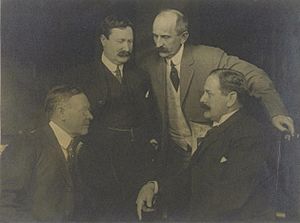San Francisco graft trials facts for kids
The San Francisco graft trials were a series of efforts from 1905 to 1908 to investigate and take action against city officials and business owners in San Francisco. These trials focused on people who were involved in dishonest dealings, where city leaders received money or favors in exchange for special treatment or contracts. The main people involved were members of the San Francisco Board of Supervisors, Mayor Eugene Schmitz, and a lawyer named Abe Ruef.
Contents
What Were the San Francisco Trials?
The trials were about a time when some people in San Francisco's city government were using their power unfairly. A lawyer named Abe Ruef was at the center of these issues. He worked closely with Mayor Eugene Schmitz. Ruef would approve many city contracts and received large sums of money from business owners. He would keep some of this money for himself and give the rest to the Mayor and members of the Board of Supervisors. This was a serious problem because it meant decisions were not being made fairly for the city.
The Fight Against Unfair Dealings
Many people wanted to stop these dishonest dealings and make the city government fair again. Former mayor James Phelan, a banker named Rudolph Spreckels, and a newspaper editor named Fremont Older were key figures in this effort. Older worked for the San Francisco Bulletin newspaper. They asked a special lawyer, Francis J. Heney, to help. Heney had a good reputation for fighting against unfair practices in other cases.
Key People Who Helped
Francis Heney took on the challenge of investigating the situation in San Francisco. He accused Ruef and Schmitz of many instances of taking money unfairly. Heney worked hard to bring them to court. During this time, there were some very difficult moments. Heney was injured during the trials, but he bravely continued his work. The efforts of these people showed how important it was to stand up for what is right and fair in government.
What Happened in Court?
The trials were long and complicated. Eventually, another lawyer named Hiram Johnson helped bring Ruef's trial to a close. After several appeals, Abe Ruef was found responsible for his actions and spent four years in San Quentin Prison. While he was in prison, he wrote articles for Older's newspaper. These articles shared details about the companies, business leaders, and public officials who were involved in the unfair dealings.
The Outcome of the Trials
Mayor Schmitz was also found responsible for his part in the events. However, after some legal processes, he did not serve any prison time. Many of the business owners and supervisors who were involved were given a special agreement. They agreed to tell what they knew about Ruef and Schmitz's actions. In return, they were not arrested or charged with crimes. Later, a new District Attorney was elected. This new official decided to stop the investigations and any further trials related to these events.
Life After the Trials
Years later, in 1912, Fremont Older, the newspaper editor, started to think differently about Ruef's situation. He asked Ruef to write his life story, which was published in the San Francisco Bulletin newspaper. Ruef was released from prison in 1915, after serving a little over four and a half years. He was the only person involved in the entire investigation who went to prison. After his release, he was not allowed to work as a lawyer again. He had been very wealthy before going to prison, but he lost all his money by the time he passed away.


